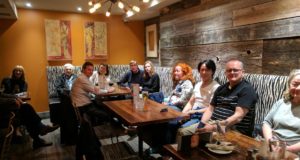Eric Morse —
The year is 1914. David Adams leaves his home at 255 Sumach St. each morning, walks north, and then a block east to the southeast corner of River and Gerrard streets where he works as an enameller for Sheet Metal Products Ltd. Later in the day, Joseph Brodie will travel 13 bulidings west from 389 Gerrard St. and cross Parliament St. to arrive at his employ as a bartender at the Hotel Gerrard.
Proximity is the best way to ease transportation woes: so reads one of the illustrated placards that make up Close to Home: How Work, Play and Life Coexist in 1914 Cabbagetown, the latest Cabbagetown Regent Park Museum (CRPM) exhibit at the Daniels Spectrum.
Through placards, amazing archival photographs and household objects (like a locally made enamelled saucepan or a “Dead Man’s Penny” individualized medallion given to every Cabbagetown—and Canadian—family that lost a son in the Great War), museum founder Carol Moore-Ede and curator Sally Gibson have done some marvellous story of social storytelling at a micro level.
The exhibit focuses on two square blocks of what was then Cabbagetown and is now Regent Park: the area bounded by Sackville, Gerrard, Sumach and Wilton (now Dundas) with Oak St. in the middle. Most of the residents worked, shopped and lived within a very short radius of their homes. It was dirty, noisy, toxic, poor, and it was intimate and sustainable.
The exhibit opened on Nov. 28 with a reception co-hosted by Artscape and catered by Dixon Hall Show Love Cafe from their KYM (Keeping Youth Motivated) program. Show Love Cafe will open at the Spectrum early in the New Year.
Starting from nothing in 2004, the Museum has amassed important collections of artifacts and oral histories. It will soon be forced to leave its current quarters at Simpson House in Riverdale Farm and there are plans to construct a new and permanent museum at the corner of Parliament and Gerrard.
Close to Home continues until mid January 2015. Visit crpmuseum.com for more information.
 TheBulletin.ca Journal of Downtown Toronto
TheBulletin.ca Journal of Downtown Toronto


